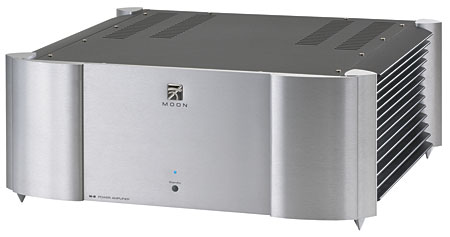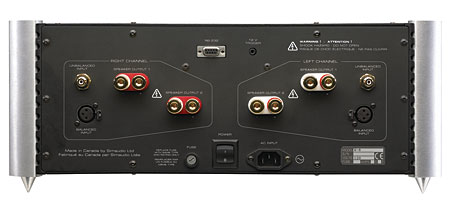| Columns Retired Columns & Blogs |
Simaudio Moon Evolution W-8 power amplifier
The W-8 ($10,200) is the first of Simaudio's Moon series to incorporate the new Evolution cosmetics and new circuitry. I loved its predecessor, the Moon W-5, which was one of the first power amplifiers I reviewed for Stereophile (March 1999, Vol.22 No.3). I also loved the "new and improved" W-5 when I wrote about in the May 2001 issue. In the September 2005 issue, Brian Damkroger praised Simaudio's monstrous Moon Rock monoblock, a contemporary of the Moon Evolution W-8 stereo amp.

Many amps may share the W-8's general dimensions, but few pack as much mass into their chassis as does the W-8—at 95 lbs, it's no mere tyke. When I tried to position it for unpacking, the W-8's carton seemed glued to the floor. Still, you'd forgive me for seeing the W-8 as "small" if you could compare it to the Moon Rocks, or to the Classé Omicrons that flanked it in my system.
The Evolution series' casework is only slightly reminiscent of the original Moon designs. There's still a spiked post at each corner, but the new front panels have gently curved surfaces, and the posts are more convex triangles than cylinders. Moreover, the balance of black and silver has shifted to the latter; black was used only as an accent on my review sample, but that was only one of 24 trim options. Overall, the Evolution is a major aesthetic enhancement of the Moon series, though I'm not sure of its Darwinian survival value. With all those smooth, curving surfaces, it wasn't easy to get a grip on the heavy W-8, lift it out of its box, and move it into position. On top of all that—or, rather, at the bottom—my sample's four footer spikes came already installed. I felt I was maneuvering the progeny of a hippo and a porcupine. Simaudio tells me that Evolution components are usually shipped with their spikes off; indeed, the Moon Evolution P-8 Reference preamp recently arrived with its spikes packed separately.
On the W-8's front panel, the only elements that are not strictly decorative are a Power button that actually switches the amp in and out of standby, and a blue LED that indicates normal operation with constant illumination, but blinks during initialization or to signal a malfunction. The W-8 will turn itself off or refuse to power up if it detects DC on any input or if it's in danger of overheating. Count how many times the LED blinks and there's your diagnosis.
The actual power switch is at the bottom of the rear panel, along with an IEC power connector and AC fuse post. Also on the rear panel, arranged in mirror symmetry, are two RCA and two XLR inputs and two pairs of substantial all-metal speaker terminals. Both sets of terminals are always live, and are easier to use than any of the supposedly safer plastic-covered, EEC-approved variety. At the top center of the rear panel are an RS-232 connector and 12V trigger in/outs.

Inside, the W-8 is a fully dual-mono, balanced differential design that uses Simaudio's new, proprietary Lynx amplification circuit, which eschews any overall feedback loop. Vertically mounted behind the front panel are two zaftig toroidal transformers; eight large power supply capacitors fill most of the remaining space. There are no capacitors in the signal paths, and the W-8's class-A output is supposedly maintained up to 5W.
Natural selections
I connected my speaker cables to the Moon Evolution W-8's output terminals and removed the shorting jumper from its XLR jacks to accommodate my balanced interconnects. AC current was supplied directly from the wall socket or via the APC S15 and EP-2450 power conditioners. At power-up, whether by switching the rear power switch or the external power controller (assuming the rear switch was on), a relay inside the W-8 clicked and the blue LED blinked for about 10 seconds, then went off. A tap of the front Power button, and I had music.
From first power-on until I packed it up again to ship to John Atkinson for measuring, the W-8 never misbehaved. I was made aware of its presence only by the LED and the music in the room. None of the relays or LEDs signaled anything else after start-up, and, considering how mercilessly I flogged it, there was never any significant heat. At most, the chassis temperature rose only slightly above that of my skin.
I used the W-8 mostly with the Revel Ultima Studio and B&W 802D loudspeakers, with brief detours to pop in the Paradigm Studio/20s and the Revel F-12s. In every case, I found the W-8 to be a capable delight—just as potent as the hulking Classé Omicrons, and power was always sufficient. The W-8 had some characteristics of the W-5, including a smooth, velvety high-frequency range, a clear and grain-free midrange, and a powerful, dynamic bottom end. Simaudio Moon amps have never been "bright"; if anything, they can be characterized as sounding a bit warm and rich. Although true to its breed, the W-8 was a thoroughly improved amp for the new century.
The W-8 was extremely open and revealing at the top end, and was adept at complementing the beauties of the B&W 802D's diamond tweeter. Together, they offered the detail and grain-free clarity one associates with ribbon drivers, but without any artificial zing or vagaries of radiation pattern. The gaudy percussion that flavors much of Concerto Köln and Sarband's Dream of the Orient (CD, Archiv 474 992-2) sounded brilliant, but remained in place and in balance with the rest of the instruments—all too often, such excellent delineation is at the expense of balance or is simulated by a spectral tilt. I heard something similar with brass instruments, whose overtones can be splattery or remind me of sandpaper. The W-8 retained both the exquisite detail and the requisite balance of the brass in the fortes of Benjamin Zander and the Philharmonia Orchestra's recording of Mahler's Symphony 1 (SACD, Telarc 2SACD-60628). My listening notes on the W-5 reveal this to be a welcome advance; the older amp had a notably softer, more forgiving treble.
- Log in or register to post comments




































